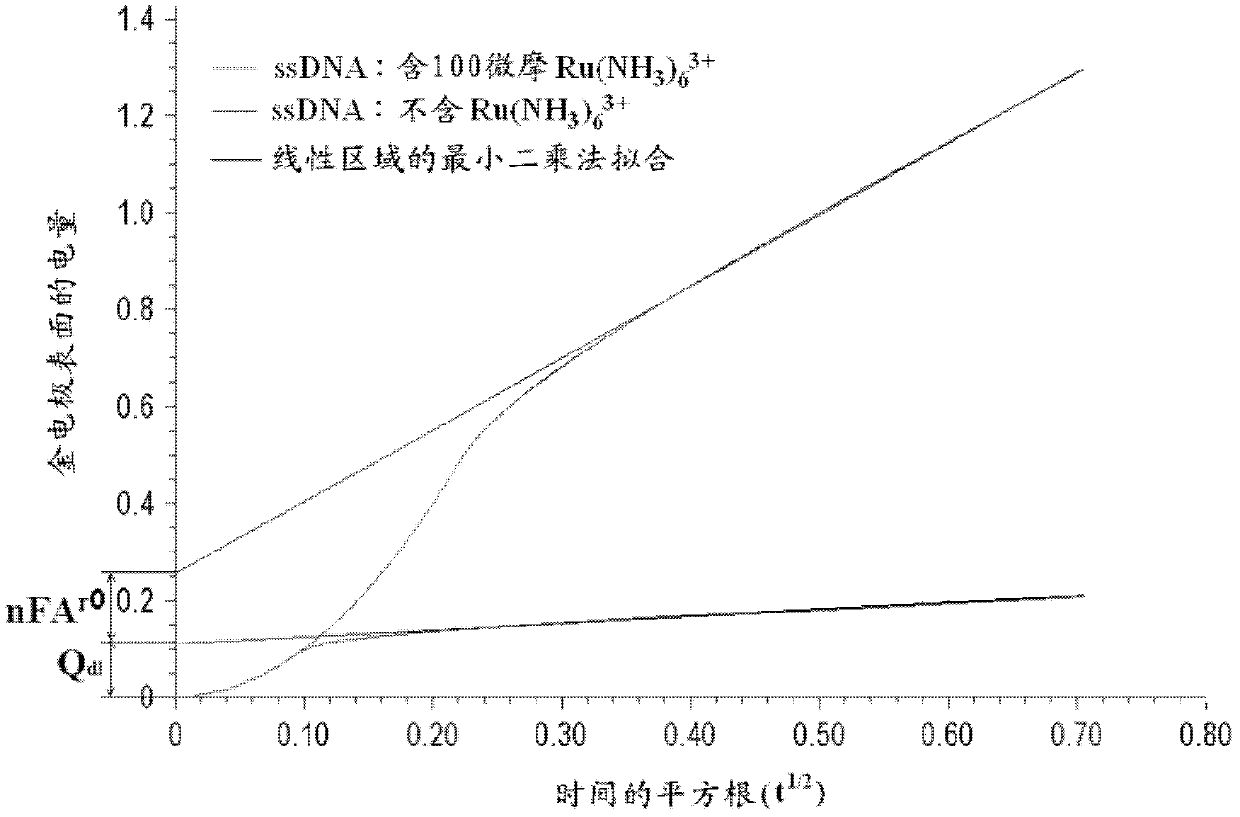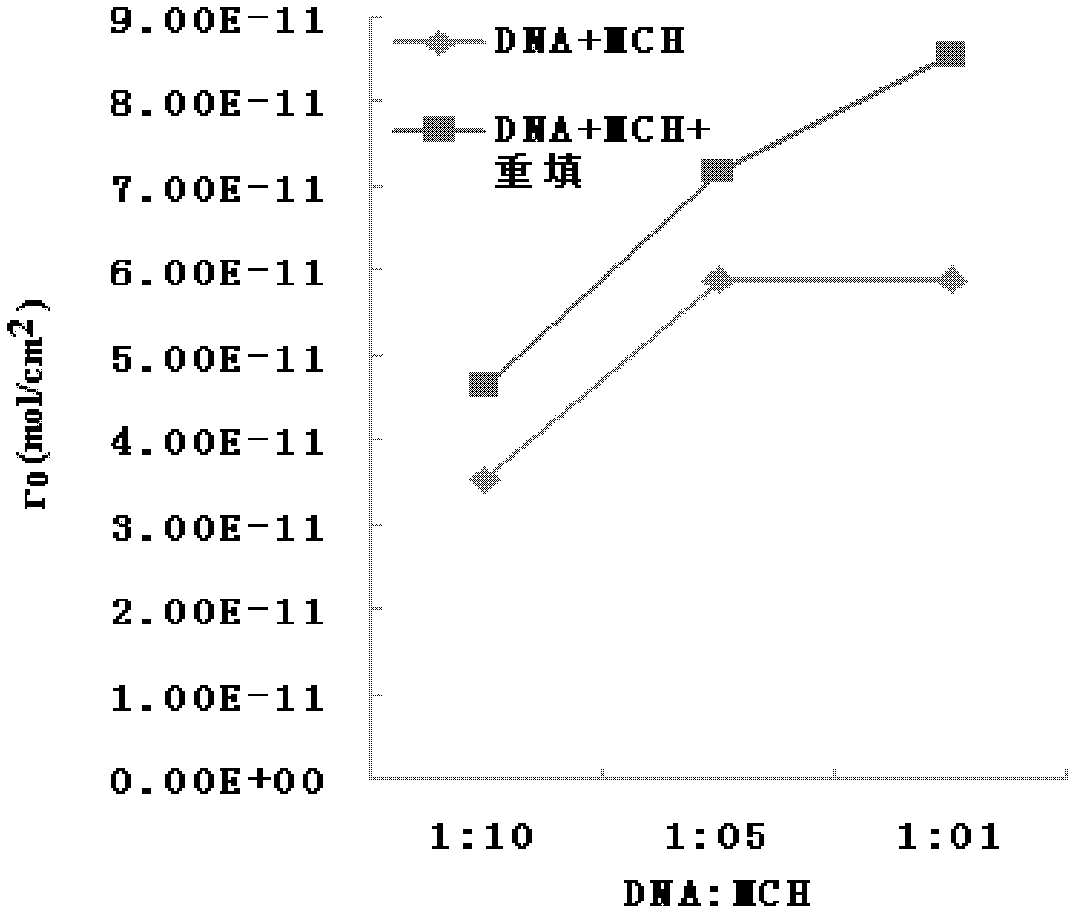Gold electrode and preparation method thereof
A gold electrode and solution technology, applied in the field of gold electrode and its preparation, can solve the problems to be improved and the like
- Summary
- Abstract
- Description
- Claims
- Application Information
AI Technical Summary
Problems solved by technology
Method used
Image
Examples
example 1
[0068] Gold electrodes were prepared according to the general method, wherein the gold electrodes were respectively placed in the above-mentioned mixed solution containing DNA and thiol for 16-20 hours of cultivation, wherein the DNA in the mixed solution containing DNA and thiol, the first The thiol solutions were mixed 1:10. Then, using chronocoulometry, measure and calculate the Ru(NH 3 ) 6 3+ Adsorption capacity, the potential range used is -300mv~-800mv, and the measurement time is 500ms:
[0069] First, place the prepared gold electrode in a blank solution, i.e. pH=7.4, 10mM Tris-HCl solution, and measure it to obtain the first curve; then, add Ru(NH 3 ) 6 3+ Solution (each phosphate group of DNA carries a negative charge, which can interact with Ru(NH 3 ) 6 3+ Adsorption occurs), and it is measured to obtain the second curve; then, based on the aforementioned two curves, the tangent of the two curves is made and the intercept is obtained, and the Ru(NH 3 ) 6 ...
example 2
[0071] The Ru(NH 3 ) 6 3+ The adsorption amount can be obtained when the volume ratio of DNA and thiol in the mixed solution containing DNA and thiol is 1:10, 1:5, and 1:1, and the corresponding adsorption amount Γ 0 , so that the volume ratio of DNA and thiol in the mixed solution containing DNA and thiol and the Ru(NH 3 ) 6 3+ Adsorption capacity Γ 0 , and taking the adsorption amount of the gold electrode that forms a primary self-assembled molecular film on its corresponding surface as a contrast, make the volume ratio of DNA and thiol in the mixed solution containing DNA and thiol and the obtained Ru on the surface of the gold electrode (NH 3 ) 6 3+ Adsorption capacity Γ 0 The relationship diagram, see the results figure 2 . Such as figure 2 As shown, the ordinate is the Ru(NH 3 ) 6 3+ Adsorption capacity Γ 0 (unit: mol / cm 2 ); the abscissa is DNA:MCH, representing the volume ratio of DNA and thiol in the mixed solution containing DNA and thiol; the red...
example 3
[0073] According to the formula Γ DNA =Γ 0 (z / m) N A , the volume ratio of DNA and thiol in the mixed solution containing DNA and thiol obtained in Example 2 and the Ru(NH 3 ) 6 3+ Adsorption capacity Γ 0 In the relationship diagram of , the adsorption amount Γ corresponding to the mixed solution containing DNA and thiol in different proportions 0 , get the density Γ of the probe DNA DNA , where Γ DNA is the density of probe DNA (unit: piece / cm 2 ), m is the number of bases, and z is the number of charges carried by the adsorbed ions. Then based on the density of the probe DNA, draw the relationship diagram of the volume ratio of DNA and thiol in the mixed solution containing DNA and thiol and the probe density on the gold electrode surface obtained, the results are shown in image 3 . Such as image 3 Shown, the ordinate is the probe density on the surface of the gold electrode (unit: number / cm 2 ); the abscissa is DNA:MCH, representing the volume ratio of DNA and...
PUM
 Login to View More
Login to View More Abstract
Description
Claims
Application Information
 Login to View More
Login to View More - R&D
- Intellectual Property
- Life Sciences
- Materials
- Tech Scout
- Unparalleled Data Quality
- Higher Quality Content
- 60% Fewer Hallucinations
Browse by: Latest US Patents, China's latest patents, Technical Efficacy Thesaurus, Application Domain, Technology Topic, Popular Technical Reports.
© 2025 PatSnap. All rights reserved.Legal|Privacy policy|Modern Slavery Act Transparency Statement|Sitemap|About US| Contact US: help@patsnap.com



